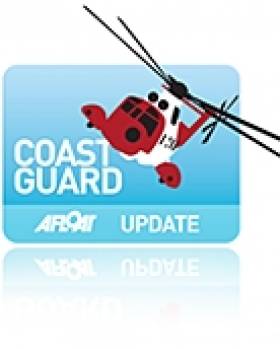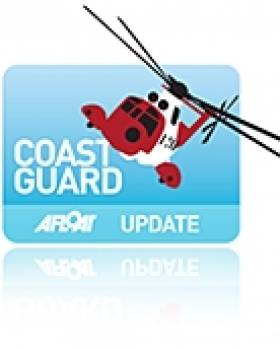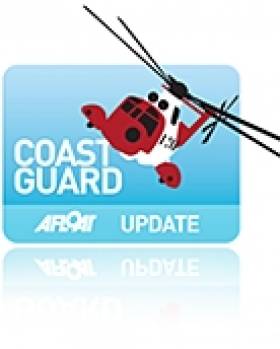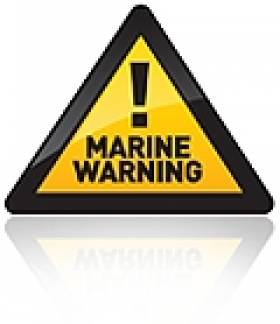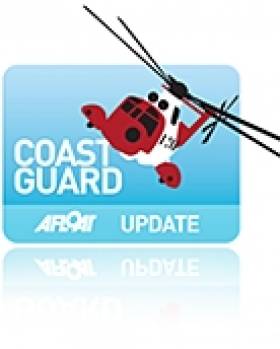Displaying items by tag: Guard
Stormy Autumn Contributed To Record 2014 Coast Guard Response Statistics
#coastguard – The Coast Guard has seen a record response for 2014, with it being particularly relevant to the Shannon SAR Helicopter who flew the Bases 300th mission last week. As Afloat.ie already reported two days ago, the Coast Guard attributes the rise in the number of incidents to:
1. Prolonged warm weather during the summer
2. More people taking holidays in Ireland (which are normally taken near water)
3. Additional work undertaken by the Coast Guard helicopters assisting the national ambulance service, particularly with medevacs of patients suffering from Strokes and STEMIS - ST Segment Elevation Myocardial Infarction
4. Storms and High winds in the early part of the year and coming into Autumn
The Coast Guard believes that the rise in the number of incidents shows a greater willingness of the community to seek assistance early, which is to be welcomed. The Coast Guard encourages people to call 112 when they think they're in trouble, as if you wait until you are in trouble it might be too late. With the change in weather, we see a change in the calls and a change in conditions but the message remains the same. If you do see someone in difficulty in the sea, on the shore, cliffs, lakes or rivers dial 112 or 999 and ask for the Coast Guard.
Total incidents at 2628 is up 3% on 2013 which had been the busiest year since the foundation of the modern Coast Guard in 1991. While we have seen a drop in the numbers of people assisted at 4,000 we have seen an increase in the number of people saved up 74% (260), due in part to our increased air ambulance work, which was in evidence last Monday during the multiple casualty RTA in Farranfore when two Coast Guard helicopters responded to the scene. The statistics for the number of people offered Coast Guard 'assistance' can be difficult to interpret, for example an assisted passenger vessel can increase numbers significantly by comparison with a single person lift.
• Powered pleasure craft are up 8% at 245
• Sailing vessels down 30% at 86
• Merchant vessels 69 incident (up 17%) show an increase partially due to the major storms at the start of the year
· Fishing vessels down 11% at 188 which were mainly tows for engine difficulty
• Highest riser is the punt/tender at 41 is up 116%
• Two other categories showing significant rises are Surfer requiring assistance (+92%) and Kite Surfer (+64%) these can be attributed to a couple of factors; rising popularity, high winds coming into Autumn and extended warm weather during the Summer
• Mountain rescue assists were up 28% at 96
• And Canoe/Kayak at 59 up 23% again possibly due to its rising popularity and warmer summer.
Another feature of the last number of years is the growing assistance we give to An Garda Síochána in missing person searches in coastal and remote areas. 220 missions this year represents a 38% rise.
Hoax calls have fallen by 52% but nuisance calls have risen 119% to 2,300.
Overall the total incidents involve 47 fatalities, 18 of which were on Gardaí assists.
SAR Helicopters
Shannon has seen a new Base record with 300 missions completed by last weekend and now stands at 311. This represents a 9% rise on our busiest year in 2013. Sligo (R118) has seen a 16% rise with 275 missions. However showing the biggest rise is Waterford (R117) with a 33% increase (188 missions) due to the good weather. Dublin completes the picture with 140 missions. This year saw the launch of our new S92's in Dublin and Waterford which completed the set and now all 4 bases using the improved new technology aircraft.
Speaking about the new Base record Chris Reynolds, Director of the Irish Coast Guard said: 'In noting this record number of missions I would like to voice the Coast Guard thanks for the professionalism and dedication of the crew at Rescue 115 and for the consistently high levels of mission availability that the Coast Guard have achieved in partnership with our service provider CHC Ireland. I also want to thank the crews at our bases in Dublin, Waterford, and Sligo for their fantastic work throughout the year, moving people from places of danger to places of safety, day and night winter and summer.'
Eugene Clonan, Assistant Director thanked all Coast Guard Staff and Volunteers who have responded throughout the year and also wished them all a safe 2015.
"I would like to thank all the staff and volunteers who have contributed to the many missions we have undertaken this year, and wish them all the best for the festive season. I would also like to thank the RNLI, CRBI, Gardaí, Mountain Rescue teams, the National Ambulance service, Fire Brigade, who we have worked together with so well throughout the year. I want to particularly thank the many volunteers who responded with such professionalism, whether that be the Coast Guard directly, RNLI, CRBI or Mountain Rescue teams."
Coast Guard volunteer units were called out 1, 269 times (13%rise), RNLI lifeboat tasked 819 times (-5%) and Community rescue Boats 210 (47% rise). There were 44 minor pollution incidents managed. Our Coordination centres also broadcast 61,600 marine safety broadcasts a rise of 25%, received 27,000 ferry traffic reports, 1,800 fishing vessel traffic reports and 6,000 leisure vessel traffic reports. The increased number of traffic reports logged particularly by fishing and leisure vessels is very welcome and the Coast Guard encourages anyone taking to sea to log a traffic report (in effect a sail plan) with the Coast Guard. All boat users should also tell a responsible person ashore – in effect an emergency contact – where their craft is going, when its leaving, from what port or slip, time due back and where, who is onboard, what safety and communications equipment is carried, what the craft looks like, its name/call-sign and most importantly what action to take when this estimated time of arrival back passes. This emergency contact ashore must take on this duty vigilantly and contact the Coast Guard immediately once they become concerned. Finally we would like to remind all who go on the water to don a lifejacket and keep it on. There is no excuse for not wearing a lifejacket and we would encourage every partner, friend or relation who knows a boater with no lifejacket to get one and wear it.
Note
Lives saved are those which were in grave and imminent danger and would otherwise have been lost but for IRCG intervention
Lives assisted were those not in imminent danger but assisted by IRCG to alleviate the predicament in which they found themselves
Two Fishermen Rescued After an Hour in the Water
Liverpool Coastguard received a 999 call from a member of the public at just after 1.30pm. The caller had heard calls for help from the water and spotted two people in difficulty off Silloth, Cumbria. Coastguard Rescue Teams from Maryport and Burgh by Sand were sent to the scene with the RNLI Inshore Lifeboat from Silloth and Maryport Inshore Rescue Boat.
The fishermen were rescued from the water by the RNLI Inshore Lifeboat and taken to hospital in Carlisle by ambulance. It then transpired that they had been fishing for shrimps at Cardurnock Flats, four miles from where they were found. It appears that their net got caught and their ten-metre fishing vessel 'Boy Bailey' turned over in the water. The vessel then sank and the men spent an hour drifting in the water, supported by life rings.
Tony Topping Liverpool Coastguard Watch Manager said:
"These fishermen were extremely lucky. Firstly they managed to grab life rings and then the tide carried them the four miles down to Silloth.
"The MCA recommends that commercial fishermen wear a personal floatation device or lifeline whilst working on the deck of a vessel at sea. This will keep you afloat should the unexpected happen and if you also have your vessel fitted with VHF DSC radio equipment which can send a distress alert you'll also have a way of calling for assistance when you need it."
70 Year Old Man Falls Over Cliff
Milford Haven Maritime Rescue Coordination Centre was alerted at just before six o'clock by a member of the public who was with the man when he fell. They immediately sent Coastguard Rescue teams from Gwbert and New Quay, the RNLI Lifeboat from New Quay and the RAF rescue helicopter from Chivenor to the scene.
On arrival they found that the man was very close to the incoming tide so he was lifted into the lifeboat and winched from there to the helicopter. He was then taken to hospital in Haverfordwest.
It's believed that the man had been out fishing and was walking to his car when he slipped five metres to the base of the cliff. He suffered serious head injuries.
Mike Rogers Milford Haven Coastguard Watch Manager said:
"This was a complicated rescue because the tide was rapidly coming in. I'd like to thank the member of the public, that reported the incident, for his assistance and the teams for their rapid response to this unfortunate accident.
Award for Helicopter Crews 'Outstanding Service' to Irish Maritime Search and Rescue
One of the world's leading helicopter services company, CHC has built up an unparalleled reputation for excellence in SAR aviation over 20 years of operations for the Irish Coast Guard.
The tireless efforts of the team, who provide a 24-hour a day service from their Shannon base, has seen them awarded a special Directors Award for Outstanding Service to maritime search and rescue in Ireland.
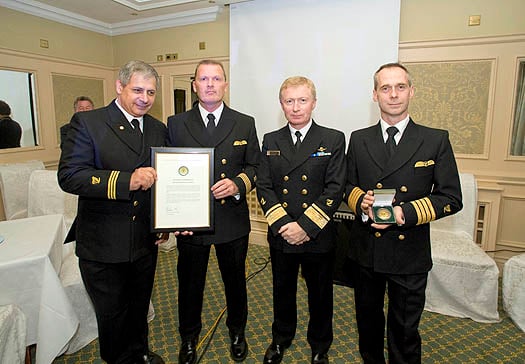
Top Brass: (from left to right) Paul Truss, Eamonn O'Broin, Chris Reynolds and Liam Flynn
The award recognises the personal commitment of all the crews, engineers and staff that have, over a period of two decades from 1991 to 2011, significantly enhanced Ireland's ability to affect a successful rescue and saved many lives.
It was accepted by Shannon Chief Pilot Captain Liam Flynn, Chief Crewman Eamonn O'Broin and Base Manager Paul Truss. Director of the Irish Coast Guard, Chris Reynolds, presented the award at a screening of a television documentary about the unit in Ennis.
The programme, called Rescue 115, will be aired on Irish channel RTE and will give people the opportunity to get an intimate view of what the crew does.
Mark Kelly, managing director of CHC in Ireland, said: "I would like to extend my heart felt congratulations to each and every member of the Shannon team past and present on the Directors Award in recognition of outstanding service to the State.
"The Directors Award is a very prestigious award which has only been given eight previous times.
"In presenting the award at the premiere of Rescue 115, Chris Reynolds spoke of the outstanding service given by the Shannon base and its staff to the State over the last twenty years, during which time it has carried out 3,732 missions.
"It is a well deserved recognition of two decades of tremendous courage, loyalty and dedication to providing a world class search and rescue service."
Earlier this year, a CHC SAR crew was recognised with a Best of Irish award for their role in successfully recovering the pilot of a light aircraft which crashed in the Irish Sea.
CHC Helicopter is the world's largest offshore helicopter operator and provides civilian search and rescue services in Ireland, the UK, Norway and Australia.
Coast Guard Advises Caution in Severe Weather
The Irish Coast Guard has advised members of the public to take care in the current severe weather conditions, particularly around the coast and in exposed areas.
Sea Activities
Avoid sea or water-based activities today if possible.
Cliff Walking
There is safety in numbers. Always let someone know when and where you are going, and when you are expected to return. Stay well away from cliff edges, both top and bottom. Don't attempt to rescue people or pets if they fell over a cliff edge. If assistance is needed dial 999 or 112 and ask for the Coast Guard.
Lough Derg Lifeboat Rescues Three after Yacht Capsizes
At 17.04hrs Saturday September 10, Lough Derg RNLI Lifeboat was requested to launch by Valentia Coast Guard following a report of two persons in the water off Hare Island, on Lough Derg. At 17.15hrs, the lifeboat was launched with Helm Colin knight, Johnny Hoare and Ger Egan on board, and was on scene 17.20hrs. The wind was southwest, force 6, with a 5ft to 6ft swell, visibility was good.
When the RNL lifeboat arrived on scene, a passing yacht was recovering two persons onto their yacht, but had lost a visual on the third person. The lifeboat immediately carried out a search pattern, located the third casualty some four or five hundred metres away, and recovered them to the lifeboat.
Lifeboat Helm Colin Knight said "these three people were very very lucky; the passing yacht only became aware of their plight when, on tacking, one of sailors heard calls for help on the wind and raised the alarm". He continued, "the persons were in the water for at least thirty minutes, in fairly hostile conditions, when the only boat in the vicinity heard their calls for help, someone was looking after them today".
Tasked by Valentia Coast Guard, the Irish Coast Guard Search & Rescue Helicopter team, Rescue 115, took off from their base at Shannon at 17.34hrs. Killaloe Coast Guard had also launched to assist. After establishing that the RNLI lifeboat could be at their station within 5 minutes, Rescue 115 requested the crew to take the casualties to Dromineer from where they5 would transfer the casualties to hospital.
The RNLI lifeboat returned to the yacht, and took a second casualty on board. Killaloe Coast Guard boat took the third person. All were then rushed back to Drominneer where they were met by the helicopter and transferred to Limerick Regional hospital for further treatment.
The lifeboat then returned to 'The Hare' to see if the sunken vessel was a navigational hazard, but there was no sign of wreckage or of the yacht. The lifeboat returned to station and was ready for service again at 18.50hrs.
While it might be an exaggeration to say that all of the 21 crew members of Rambler 100 owe their lives to the Irish Search and Rescue service, there are certainly five people whose future prospects were greatly improved by the operation off the Fastnet Rock on August 15th. A lot of media focus has been on Coxswain Kieran Cotter and the crew of Baltimore Lifeboat as well as lifeboat mechanic Jerry Smith, whose dive boat, on charter to the media team of one of the competitors, was on hand to search and recover the five drifting crew. There is no question that this focus is appropriate. RNLI crews all over the UK and Ireland deserve the attention, not only because of their extraordinary voluntary dedication to the cause, but also because such publicity helps swell the coffers of the charity. The service could not operate without the generosity of the donors and incidents such as these help fill the blue boat-shaped boxes held by even more RNLI volunteers.

Saved: Ireland's Rescue Services Answered the Call of the capsized Supermaxi Rambler 100 off the Fastnet Rock. Photo: Team Phaedo
The dramatic stories and pictures dominating the media show the front line of a quite wonderful resource that is Search and Rescue in Ireland today. Baltimore Lifeboat was at the coal face of an intricate network of operations, triggered by the crew's EPIRBs. Irish Coast Guard radio officers in Valentia responded almost immediately tasking the rescue resources, working the phones and computers to confirm that this was not an accidentally triggered EPIRB, contacting RORC HQ, determining search patterns and relaying the information to the scene. It was the backroom contacts between RORC and the Coast Guard in endeavouring to contact Rambler 100 using satellite phones that confirmed the possibility of a catastrophic incident involving the Supermaxi. The subsequent tasking of the Shannon and Waterford based Sikorsky helicopters led to the medevac of crew member Wendy Touton and timely treatment of her hypothermic condition, initially by the on-board paramedics and later at Tralee General hospital. And Coast Guard involvement didn't end with the successful rescue – the shoreside operation to provide food and shelter in Baltimore was coordinated by Coast Guard personnel and the salvage operation of the hull of Rambler 100 was overseen by the Irish Coast Guard.

Rambler crew are recovered from the water after a SAR operation by the Irish Coastguard Photo: Team Phaedo. More photos here.
That Ireland has probably one of the best Search and Rescue services in the world goes back to the campaign initiated in 1988 by Joan McGinley, following the death, within sight of land of Donegal fisherman John Oglesby, whose leg was severed in a trawl winch. Eamon Doherty, the late former Garda Commissioner chaired the review group established in response to the campaign and his report led to the establishment of the Irish Marine Emergency Service, subsequently the Irish Coast Guard. Under the guidance of Director Capt Liam Kirwan, the new service moved quickly to become not only the central co-ordinating body for Search and Rescue, but developed its own resources, notably the helicopters, previously tasked in from Irish Air Corps and UK SAR.
Another element that will feature in the Rambler 100 incident is the Marine Casualty Investigation Board (MCIB), set up from recommendations arising from a review of the handling of investigations into marine casualties.
It might be thought that the incident is now closed, but there are many unanswered questions and the investigation will be looking at these and making recommendations that should improve safety in this sector. These questions will include EPIRB performance, liferaft deployment and grab bag usage, but perhaps the key issue yet to be determined is why the response from fellow competitors didn't appear to happen. Even if Channel 16 wasn't being actively monitored, and if not why not, shouldn't the Mayday set off by the Coast Guard have set off the DSC alerts on the radios of Rambler 100's fellow competitors? Had the incident occurred several hours later or earlier when Rambler 100 could have been up to 100 miles from the nearest land, when conditions worsened, we could be looking at much more serious consequences.
It is heartening to think that, in this small country of ours in troubled times, not only do we have a shining star in our search, rescue, recovery and restore system, involving professionals and volunteers cooperating for the greater good, we also have a system that determines the nature of incidents so that we can all learn from the experience.
And let us not forget those people and services, such as the Gardai, Navy, Army and the community of Baltimore who are outside the media spotlight who contributed to this happy ending.
Afloat's Latest Coastguard News
Afloat's Latest RNLI Lifeboat News
Afloat's Latest MCIB News
Coast Guard in Fourth Medical Evacuation This Week
The incident was co-ordinated by the Marine Rescue Co-ordination Centre of the Irish Coast Guard at Valentia which tasked the Shannon-based helicopter this morning to travel with an A&E Registrar from Cork University Hospital to treat the injured crew member en-route. Crews on these helicopter are also trained to paramedic standard. The helicopter arrived on scene at 14:37pm this afternoon and crew and medical personnel administered treatment to the casualty. The helicopter travelled onward to Tralee Regional Hospital where it arrived at approximately 16:30pm this afternoon. The Air Corps Casa aircraft provided top-cover for the helicopter during this incident.
Irish Sea Sailor Makes Call for Help
It transpired that the caller was a sailor onboard his catamaran with his wife south of the Isle of Man who had taken some water on the vessel and believed that he was sinking.
Liverpool Coastguard working with the coastguards at the marine operations centre, Douglas on the Isle of Man requested the launch of the Port St Mary and Port Erin RNLI lifeboats to locate the vessel and render assistance.
The lifeboats located the vessel and pumped water from one of the hulls and towed it into port.
Paul Parkes, Watch Manager, Liverpool Coastguard said:
We recommend that you have adequate training in the use of VHF radio equipment, to ensure that when you have a situation that causes you concern, you make the appropriate call to secure the best possible response.
It is recommended that you fit VHF DSC radio equipment to your vessel which would enable the Coastguard to receive an accurate position of your vessel.
Agreement Strengthens Irish and French Search and Rescue
The Irish Coast Guard has signed up to an important Search and Rescue cooperation agreement with the French Coast Guard.
Director of the Irish Coast Guard Chris Reynolds and Vice Admiral Anne-Francois de Saint-Salvy, Prefecture for the Atlantic Region and the Director of the French Coast Guard this morning signed an important agreement in Dublin on co-operation regarding Search and Rescue services.
The agreement further strengthens Irish and French co-operation for search and rescues services in the respective search and rescue regions.
The International Convention on Maritime Search and Rescue provides for and encourages neighbouring countries to co-operate and assist one another in life-saving matters of search and rescue.
This technical agreement allows for the mutual cooperation and interoperability of aviation assets in the event of a major incident off Irelands south coast.
Both Coast Guards can provide either long range medium load helicopters or fixed wing aircraft that can intervene directly in support of the responsible coordinating search and rescue authority. While these events are rare it is necessary that such eventualities be considered and practised so as to be prepared for any eventuality.
Both Coast Guards absorb their own costs and so no additional burden is placed on the State. Both Coast Guards also recognise that similar support may be possible in the event of ship casualties within their respective Exclusive Economic Zones (EEZ) such as obtaining top cover for a long range helicopter mission to put a salvage team aboard a stricken vessel in our region.
In all these scenarios the Irish Air Corps will remain the Irish Coast Guards first call for fixed wing top cover from their CASA aircraft.
Speaking today, Director of the Irish Coast Guard, Chris Reynolds said: "This agreement is a very welcome development and will be mutually beneficial to the search and rescue capability provided by both our countries."


























